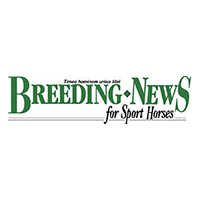By Authors named at end of article
Photography/Graphics: Authors
To give this article its full title: The Effect of lunging with three aids on the thermographically determined temperatures of the distal portion of horse limbs. Highlights include the use of rubber bands to load all four limbs, triangle side reins to increase load, and the changes in pattern of superficial hoof temperature depending on the lunging aid used.
The regulation of head and neck position during physical exercise may be obtained using lunging aids (LAs): Chambon (CH), rubber band (RB), or triangle side reins (TR). The use of LAs would shift the center of horse mass caudally, thereby change the limb load. The aim is to evaluate the pattern of superficial temperatures (PST) of hoof wall (HW), the coronary band (CB), and the dorsal aspect of the fetlock joint (FJ) obtained before and after lunging with LAs and freely moving head (FMH).
Sixteen horses were imaged using an infrared camera. The temperatures of HW, CB, and FJ were measured, and differences between images obtained before and after lunging were evaluated. The correlations between HW, CB, and FJ were then described using respective coefficients (r, rho). Before lunging PST was similar (P < .05) in FMH, CH, RB, and TR, with the strong positive correlations for forelimbs (HW/CB:rho = 0.9022; HW/FJ:rho = 0.7064; CB/FJ:rho = 0.8010) and hindlimbs (HW/CB:rho = 0.7287; HW/FJ:r = 0.7831; CB/FJ:r = 0.7233). After lunging, PST and correlations changed (P > .05) depending on LAs application. No correlations for FMH and CH, and positive correlations for RB and TR were noted: HW/CB for forelimbs (RB:r = 0.6813; TR:r = 0.8396), CB/FJ for hindlimbs (RB:r = 0.5621; TR:rho = 0.4579). The PST of the distal portion of limbs and relations between measured temperatures change depending on used LAs.
1. Introduction
Training methods of sport horses use various techniques and aids to influence weight-bearing between forelimbs and hindlimbs. It has been shown that changes in head and neck position (HNP) caused by the reins influence kinetic variables more significantly in forelimbs and less in hindlimbs[1]. The regulation of HNP during physical exercise, without the intervention of a rider, is obtained using special lunging aids (LAs) by forces acting on the bit, head, breast, girth, or/and withers[2,3]. Among LAs, the rubber band (RB) and triangle side reins (TR) close the angle between head and neck (HNA), whereas the Chambon (CH) opens it[1].
Some authors suggested that the correct use of reins closing HNA would shift the center of horse mass caudally, thereby, increase the force put on hindlimbs[4,5]. However, little is still known about how different riding aids influence the load of the distal portion of horse limbs. Therefore, it is difficult to predict whether using specific riding techniques and lunging aids is advantageous for the horse or may increase the risk of soft tissue injuries. An understanding of the influence of LAs on the limb load is important in clinically healthy horses to conduct appropriate comparisons in a case of overload.
The changes in surface heat emitted from injured tissue can be detected by infrared thermography, the non-invasive imaging technique allowing to identify areas of inflammation and blood flow alterations[6,7]. Infrared thermographic imaging allows the detection of temperature changes before such changes can be detected by palpation [8,9] and before the onset of other clinical signs of injury[9,10]... To read the complete article you need to be a subscriber
CLICK HERE TO SUBSCRIBE TO BREEDING NEWS
SUBSCRIBERS CAN READ THE COMPLETE ARTICLE BY LOGGING IN AND RETURNING TO THIS PAGE




